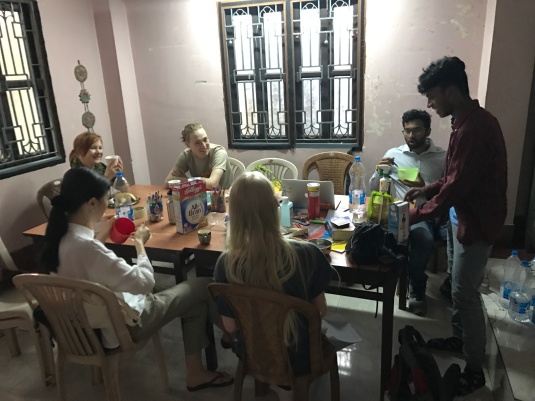It didn’t take long for us to see why Kolkata is termed “the City of Joy.” The city is vibrant, with streets packed with cars, motorcycles, and auto rickshaw honking at each other continuously. Parallel with the main roads are huge street lights decorated vividly with blue and white lights along the pole. The sidewalks are lined with hawkers, all selling local cuisine none of us brave enough to try on our first day.
Stray dogs and people sit side-by-side along the streets, both watching the colourful billboards advertising dreams of an extravagant life. The same sidewalks bustling with hawkers are crowded with litters and overflowing with sewage water. These contrasts have been the reality for the locals here in Kolkata.
Dr. Sujit always emphasised the importance of “simple people, simple work, simple life” and these are clearly reflected in the house, with its thin mattresses and cold waters. When we arrived, we were greeted with open arms by volunteers from Italy, Sweden, Finland, and New Zealand. For the next couple of days, they become our tour guide, mentor, and of course, friends.

Pictured: Susanna, Michelle, Tuomo, Laura, and Kash. Saish is in the background eating breakfast he stole from all 5 volunteers above
Our first clinic experience starts with a trip to Chakberia. Saish, Elly, Rikki, and I were accompanied by two other Australians and two Finnish volunteers. The eight of us arrived early morning at the IIMC centre in Sonarpur via train and auto rickshaw. We then travelled in a van heading to a small clinic an hour away, South of Kolkata.
Hundreds of villagers crowded the entrance of the small two-storey clinic. We got off the van and went straight to the second floor, where Tuomo (from Finland) and Leah (from Melbourne) taught us the basics of dressings and injection. Most incoming patients had fungal skin infections. For that, we first lathered the infected area with soapy water and betadine. Once dry, we applied the appropriate medications of either Q-derm, gentamicin, betamethasone, or clotrimazole.
Naively thinking that hand gestures would be sufficient, we soon realise how significant the language barrier is. The interactions were noticeably impersonal and miscommunications occur regularly throughout each consultation. I remembered having done taking a patient’s blood pressure, I finished off by saying “amar haye geche” (translation: I’m done). She nodded and smiled, although she did not get up. Confused by this, I repeated the phrase which was met with the same smile. This went on for quite a while until, finally, she pointed at her left arm. I’ve forgotten to take the cuffs off. She laughed at the ridiculousness of the situation, a gesture understood in both our culture, which seemingly shattered that barrier between us.

Pictured: Elly, Rikki, Saish and I with the IIMC bus.
For real change to occur, IIMC understands that the clinic work must be complemented with educational and sponsorship programmes. What I love about IIMC is that they were not founded solely for “voluntourism”. Every day we are working with locals truly dedicated to making a difference in their own city.
Gerardo Arwi

This is so beautifully written Gerardo and bringing back so many wonderful memories! Have the best time in Kolkata.
LikeLike
This was sooooo good! Can’t wait to read the rest of it and see how much Saish get’s picked on hehe
LikeLike